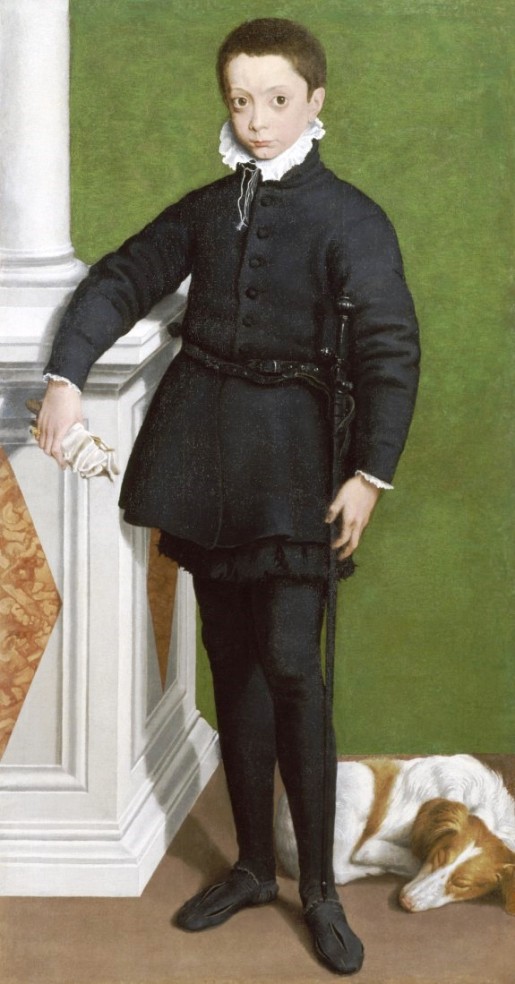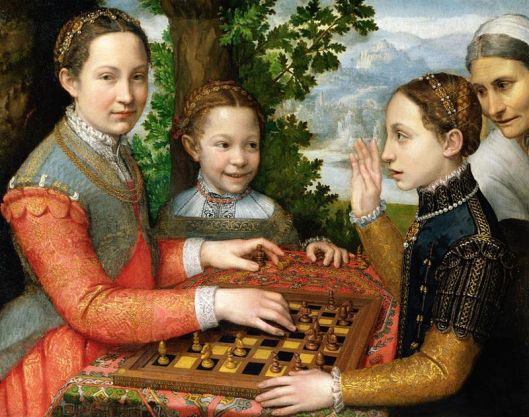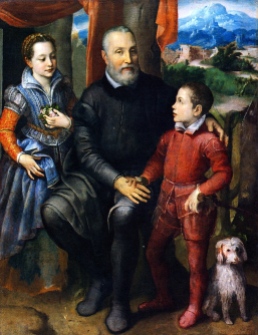Tags
Élisabeth de Valois, education, Italian Mannerist Painter, Philip II of Spain, Renaissance, Sofonisba Anguissola

Sofonisba Anguissola, self-portrait
Sofonisba Anguissola
Sofonisba Anguissola (c. 1532 – 16 November 1625) is the third Renaissance artist we are discussing. She is considered a Mannerist painter.
Sofonisba was the oldest of seven children, six daughters and a son, born to Amilcare Anguissola and Bianca Ponzone. Sofonisba’s father was an aristocrat. Britannica describes him as wealthy and Wikipedia, as impoverished. It is not a contradiction. It simply means that Sofonisba lived comfortably but that her father could not provide six dowries to marry his daughters. He therefore decided that his daughters would be in a position to earn an income and bring some wealth to a potential spouse. Amilcare was centuries ahead of his times and both a realistic and responsible father. The Anguissola sisters therefore received a “well-rounded” education which included the fine arts. Lucia, the most promising of the Anguissola sisters, died at a young age. One sister entered a convent. The others married.
Sofonisba and her sister Elena apprenticed to Bernardino Campi (1522–1591), at his home for three years. She also apprenticed to Bernardino Gatti, il Sojaro (1495-96 – 22 February 1576). This was a precedent. Other families emulated the Anguissola family. Sofonisba’s sisters, Lucia, Minerva, Europa and Anna Maria apprenticed to Sofonisba. Sofonisba then travelled to Rome where she met Michelangelo (March 1475 – 18 February 1564) for whom she executed a drawing he liked. She also travelled to Milan and painted the Duke of Alba.
In short, Sofonisba had a privileged and happy upbringing and the future bode well for her, as her father wished. Moreover, Italy is where the scholars, who fled Byzantium in 1453, had settled. The Renaissance began in Italy. It follows that Italy was the right milieu for artists. As for Sofonisba, she had the privilege of being born to enlightened parents. She therefore spent a lifetime doing what she loved.
Alessandro Farnese, Duke of Parma, c. 1561 (Pinterest)
Élisabeth de Valois (Photo credit: Wikipedia)
Marquess Massimiliano Stampa (courtesy: The Walters Art Museum, Baltimore)
Sofonisba Anguissola by Anthony Van Dyck (Photo credit: Wikipedia) (7)
The Double Portrait, Bernardino Campi and Sofonisba (Photo credit: Wikipedia) (8)

Marquess Massimiliano Stampa (courtesy: The Walters Art Museum, Baltimore)
Madrid : 1559
The Duke of Alba, whom she painted, recommended her to no less than Spain’s most prominent monarch, King Philip II (Felipe II). Philip II had married French princess Élisabeth de Valois (2 April 1545 – 3 October 1568) whom he was very fond of and who enjoyed painting. Hence his recruiting Sofonisba who earned the rank of lady-in-waiting to the Queen consort. She was also an attendant to the Infanta Isabella Clara Eugenia. Germaine Greer writes that in Sofonisba’s days, “painting was a craft practiced by menials,”[1] which may explain why Sofonisba was named attendant to the Infanta. However, Sofonisba was employed and young Élisabeth, very pleased with her artist lady-in-waiting, with whom she spent the remainder of her brief life. Moreover, Sofonisba was a court painter.
At the court of Spain, Sofonisba Anguissolla was a portraitist mainly. According to the Encyclopædia Britannica, “Anguissola’s paintings of this period are no longer extant, having burned in a fire in the Prado in the 17th century.”[2]
Marriages: the Dowry
Accounts vary as to dates, so I will simplify matters by saying that after the Queen died, at the age of 24 after a miscarriage, Felipe II provided Sofonisba with a dowry and married her to an aristocrat, Sicilian nobleman Fabrizio de Moncadas. After Fabrizio’s death, Sofonisba met Orazio Lomellino, the captain of the ship taking her to Cremona and she married him. Sofonisba and her husband lived in Genoa where Sofonisba continued to work as a portraitist, but also executed religious works. She died in 1625, at the age of ninety-three. Anthony Van Dyck visited her when she was in her 90s. He found her mentally alert and made a portrait of her. By then, Sofonisba, who was wealthy, had become of patron of the arts.
RELATED ARTICLES
- On Artist Sofonisba Anguissola (4 March 2016)
- On Artist Artemisia Gentileschi (28 February 2016)
- On Artist Lavinia Fontana (17 February 2016)
With kind regards to everyone. ♥

The Chess Game (Portrait of the artist’s sisters playing chess), 1555 (Commons Wikimedia)

Portrait of Sofonisba by Anthony Van Dyck (Photo credit: Wikipedia) (7)
____________________
[1] Germaine Greer, The Obstacle Race, (New York: Farrar Straus Giroux, 1979), p. 180.
[2] “Sofonisba Anguissola”. Encyclopædia Britannica. Encyclopædia Britannica Online.
Encyclopædia Britannica Inc., 2016. Web. 04 mars. 2016
<http://www.britannica.com/biography/Sofonisba-Anguissola>.

© Micheline Walker
4 March 2016
WordPress
Bernardino Campi painting himself and Sofonisba
(Photo credit: Wikipedia) (8)






Lovely, even haunting.
LikeLike
Thank you Paul. She was an extraordinary artist. There is something haunting about her eyes.
LikeLike
Thank you. Micheline, for this thorough introduction to an artist I had not heard of. The slide show was fascinating, as was recognising her young self in Van Dyke’s portrait
LikeLike
I could also see the young Sofonisba in Van Dyke’s portrait. I’m glad he went to see her. It was a nice gesture on his part.
LikeLiked by 1 person
Yes
LikeLike